USA Passes 12 Million Covid — 19 Cases
USA Passes 12 Million Covid — 19 Cases
The country has also set a hospitalization record. Pfizer asked the F.D.A. for emergency approval of its vaccine, which might start being deployed by mid-December.
U.S. records 12 millionth case as virus surge gathers speed.
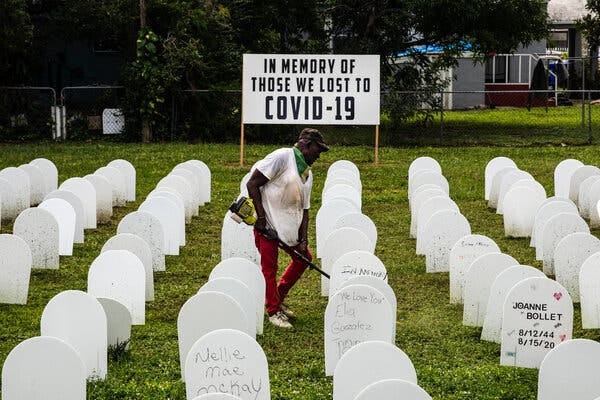
A man trimming the grass at a memorial for those who have died from Covid-19 in Miami on Saturday.Credit…Scott McIntyre for The New York Times
The United States passed 11 million total coronavirus cases on Sunday, and its caseload has now soared past 12 million. New daily cases are approaching 200,000: on Friday, the country recorded more than 198,500, a record.
As the nation reconsiders the usual winter holiday travel and cozy indoor gatherings, new cases are being reported at an unrelenting clip. The seven-day average has exceeded 100,000 cases a day every day for the last two weeks, according to a New York Times database. Read more News
The country’s death toll from the virus stood at 254,320 as of midday Saturday. And a Times analysis shows that the United States has death rates that are higher than normal in all 50 states, as the pandemic brings unusual patterns of death. Read more News
The latest virus surge began accelerating across much of the country in mid-October. It took just over two weeks for the nation to go from eight million cases to nine million on Oct. 30; going from nine to 10 million took only 10 days. From 10 million to 11 million took just under seven days. Read more News
Despite near-daily records for both new cases and hospitalizations, there remains bipartisan reluctance toward issuing the sort of sweeping stay-at-home orders seen in the earliest days of the pandemic. In their place, officials are instituting 10 p.m. curfews, closing schools and announcing long-resisted mask mandates. Read more News
In Illinois, residents received what once might have been considered an apocalyptic warning on their phones Friday evening: “Effective today, all of Illinois enters Tier 3 Mitigation. Work from home when possible, avoid unnecessary travel, and celebrate the holidays virtually with extended family.” The state has averaged more than 12,000 cases per day for the past week and some regions of the state are down to just a few dozen I.C.U. beds.
Still, the citizenry’s resolve is wearing thin. Read more News
And as families weigh whether to gather for Thanksgiving, creeping back into headlines are the hours-long lines for tests, the overwhelmed hospital systems and the demand for additional refrigerated morgue trucks.
The Centers for Disease Control and Prevention has urged Americans to avoid travel for Thanksgiving and to celebrate only with members of their immediate households. It remains unclear if many families across the United States will alter their holiday plans, despite pleas from government officials and public health experts. Read more News
“It will not be long before we can embrace one another, eat together and let this year become a distant memory,” Dr. Elisabeth Poorman, an internal medicine physician, wrote for NPR. “I beg of you, don’t let this Thanksgiving be your last.”
https://steemit.com/news/@moonhd/megan-thee-stallion-s-ex-friend-kelsey-nicole-responds-to-shots-fired-diss-i-would-never-want-a-soul-like
https://sites.google.com/view/usa-passes-12-million-covid-19
https://movienews.substack.com/p/usa-passes-12-million-covid-19-cases
https://newsjapanin.blogspot.com/2020/11/usa-passes-12-million-covid19cases.html
https://www.guest-articles.com/news/usa-today-us-passes-12-million-covid19cases-21-11-2020
https://dcm.shivtr.com/forum_threads/3272424
https://thesanguy.com/forum-mobile/topic/usa-passes-12-million-covid%e2%80%8a19-cases-no-more-dat-body
https://blog.goo.ne.jp/firsteverythingme/e/03907bf3961346eb9d4ca5f6bc47530c
https://newsfortodays.hatenablog.com/entry/2020/11/22/062147
https://macono96.tumblr.com/post/635430547452248064/tyugkhjhvgbgfvb
https://www.hybrid-analysis.com/sample/2234c1dd699a82b42435345a48c03bea38d5e8269f1811c76ed022f31114d73a
https://caribbeanfever.com/photo/albums/fdghjhcgvbn-sdfghjm
http://beterhbo.ning.com/profiles/blogs/esrdtfgytghbvgyfdrxftyghj-4
https://www.peeranswer.com/question/5fb9832c5e14b08f6e3c0f83
https://www.topfind88.com/post/903282/full-freaky-2020-watch-hd
https://www.wsearch1.com/link/68809/xcvghbfgvhbjvhjxgjnkm-gtygujh
https://www.posts123.com/post/903284/full-freaky-2020-watch-hd
https://paste2.org/czv4zJ5z
https://friendpaste.com/39HnuLAeJbnyDcbA2RGs7g
https://note.com/macono65r/n/nb04646061d8e
https://pastebin.com/KRT3fwWr
https://onlinegdb.com/SyxEuLbvcv
http://paste.jp/67644538/
https://paiza.io/projects/Tb0NU4J24_vo70-UXe_Ycg
CORONAVIRUS NEWSLETTER
As the U.S. heads into a perilous holiday season, we asked some colleagues and experts — including Dr. Anthony Fauci, the nation’s top infectious disease expert — about how we should think about the next few months.
The records are falling at a time of great political tension. President Trump has refused to concede his loss while largely ceding the fight against the virus to state and local governments who continue to go their own way, and President-elect Joseph R. Biden Jr. argues in vain for a start of the transition, warning that failing to do so will cost lives.
Dr. Deborah L. Birx, the Trump administration’s coronavirus response coordinator, has been issuing dire assessments, urging Americans to “increase their vigilance” as they await the approval of a vaccine.
She implored Americans on Thursday to practice social distancing and to wear masks.
The national rhetoric is slowing shifting. Gov. Kim Reynolds of Iowa, a Republican, announced a statewide mask mandate this week after months of insisting it was an unenforceable “feel-good measure.” Iowa has the sixth-highest rate of new cases in the nation.
“If Iowans don’t buy into this, we lose,” Ms. Reynolds said, warning that the hospital system could collapse. “The cost in human life will be high.”
— Rebecca Halleck and Neil MacFarquhar
U.S. hot spots ›
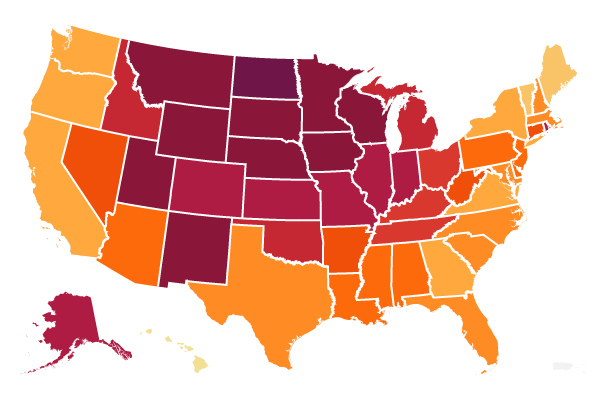
College cases ›
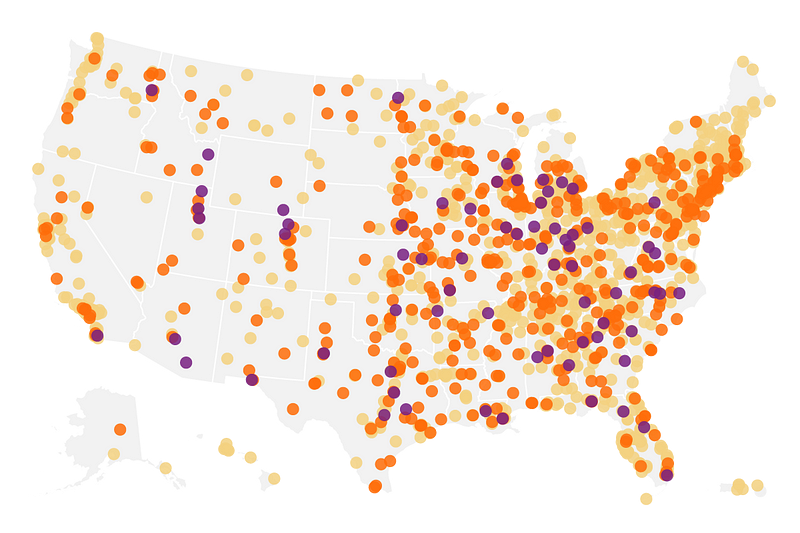
Worldwide ›

As curfews multiply, the U.S. breaks more records for new cases and hospitalizations.
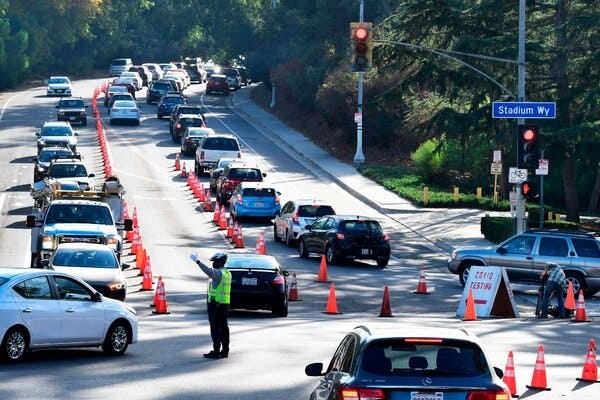
Lines for coronavirus testing at Dodger Stadium in Los Angeles on Friday, when the United States topped 12 million total cases.Credit…Frederic J. Brown/Agence France-Presse — Getty Images
As the United States continues breaking record after record — over 198,500 new cases in a single day on Friday, more than 82,000 people hospitalized — some states and cities are hoping nightly curfews will help stop the coronavirus from leaping person to person at bars, parties and other nocturnal events.
California is the latest to issue an overnight curfew, a measure more often imposed to calm public unrest than for the sake of public health.
Gov. Gavin Newsom of California, a Democrat, issued the order for most of the state’s counties on Thursday, requiring that, beginning Saturday, people not leave their homes between 10 p.m. and 5 a.m. except for essential reasons, and that restaurants close for dining then as well. Gov. Mike DeWine of Ohio, a Republican, issued a similar curfew that went into effect on Thursday.
At the local level, some areas have also imposed curfews, such as Pueblo, Colo., and Miami-Dade County, Fla., while several cities, including New York and Chicago, have shut down bars and restaurants at 10 p.m.
The measures also show how widely the response to the virus can vary by state. None of the states where the virus is spreading at the fastest rates — South Dakota, North Dakota, Wyoming, Iowa and Nebraska — have issued curfews, even as governors of some of those states have begun to require face masks indoors for the first time.
The changes come as the virus has, on average, infected more than 168,000 new people and killed more than 1,400 others each day over the seven-day period that ended on Friday.
Public health officials have repeatedly warned that the virus can spread more easily at late-night gatherings as people shout, sing, get closer to each other or, perhaps, flout the rules as they drink. In June, health officials in Ada County, Idaho, which includes Boise, determined that half of the area’s newly sick were people who had likely gotten the virus from bars and nightclubs.
“The rules for when bars are open are supposed to be that you can come down with your group and you don’t interact with others,” said Mayor Nicholas Gradisar of Pueblo, Colo., a city of about 112,000 people where a curfew has been extended to Nov. 27. But people sometimes don’t follow those rules after they have been drinking, he added. “That’s how this virus spreads.”
Public health experts also caution that it can take several weeks for measures like mask mandates, restaurant closings and restrictions on gathering to influence people’s behavior and start to flatten the epidemic curve. The effect may be delayed because the incubation period for the disease is up to 14 days, so some proportion of the public is already infected.
A spokesman for Mr. DeWine said he believed Ohio’s three-week curfew “can make a dent” in the state’s rising cases while letting bars and restaurants continue to make money by serving people earlier in the evening.
Dr. Mark Ghaly, the secretary of California Health and Human Services, said that the state’s curfew was targeted to stop the most harmful behaviors.
“We’ve seen in the past that Covid goes from zero to 60 miles per hour very quickly,” he said at a news conference on Thursday. “We know that those who are out, who might be engaging in higher-risk behaviors, that those infections can quickly spread to other settings.”
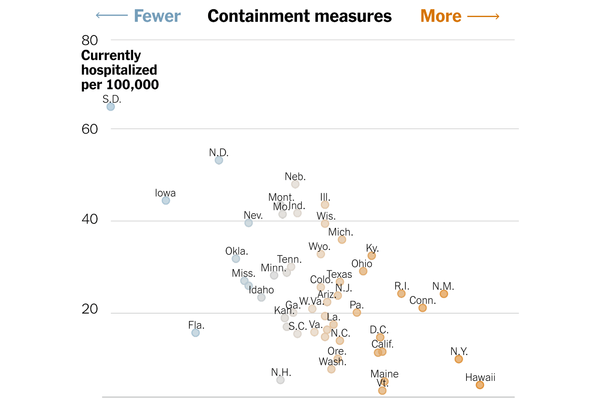
States That Imposed Few Restrictions Now Have the Worst Outbreaks
Using an index that tracks policy responses to the pandemic, The Times analyzed outbreaks in each state relative to the state’s most recent containment measures.
— Nicholas Bogel-Burroughs, Kwame Opam and Concepción de León
ADVERTISEMENT
Continue reading the main story
Pfizer applies for emergency authorization of its vaccine.
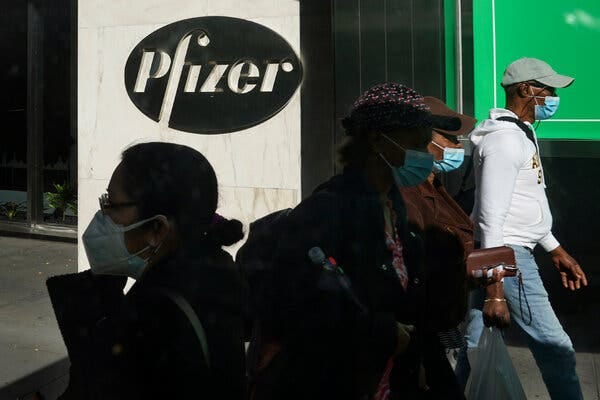

Pfizer has said its coronavirus vaccine is 95 percent effective.Credit…Bebeto Matthews/Associated Press
The drug maker Pfizer said on Friday that it had submitted an application to the Food and Drug Administration to authorize its coronavirus vaccine for emergency use, setting in motion an accelerated regulatory process that could allow the first Americans to get a vaccine by the middle of December.
Pfizer and its German partner, BioNTech, announced on Wednesday that the vaccine was safe and 95 percent effective, and that it also worked well in older people and in preventing severe Covid-19. Another front-runner, Moderna, said on Monday that its vaccine, which uses similar technology, was 94.5 percent effective and that the company also expected to apply soon for emergency authorization.
The two vaccines use a synthetic version of coronavirus genetic material, called mRNA, to program a person’s cells to churn out many copies of a fragment of the virus.
An emergency authorization would allow limited groups of Americans to get the vaccines before the F.D.A. has completed the typical monthslong approval process. Agency officials have made clear through new guidelines that their bar for emergency authorization will be high.
The F.D.A. regulators plan to take about three weeks to review Pfizer’s vaccine, which spans thousands of pages, before an outside panel of experts meets to review the application. That meeting has been scheduled for Dec. 10.
The agency typically, though not always, follows the advice of its advisory committees. If committee members reach a consensus about the effectiveness of Pfizer’s vaccine, the company could receive emergency clearance by mid-December.
Because Moderna is also on the verge of submitting its vaccine for emergency approval, the outside panel could review the company’s vaccine soon after Pfizer’s.
If both vaccines are authorized for emergency use, federal and company officials have said, there could be enough doses to immunize about 20 million Americans before the end of the year, a group that would most likely include health care workers and nursing home residents. There are an estimated 17 million to 20 million health care workers in the United States, and about a million people living in nursing homes.
In a video message Friday, Pfizer’s chief executive, Dr. Albert Bourla, called it a “historic day,” and said, “It is with great pride and joy — and even a little relief — that I can say that our request for emergency use authorization for our Covid-19 vaccine is now in the F.D.A.’s hands.”
Pfizer said on Friday that the company has begun regulatory submissions in Australia, Canada, Europe, Japan and Britain, and that it planned to apply in other countries “in the immediate future.”
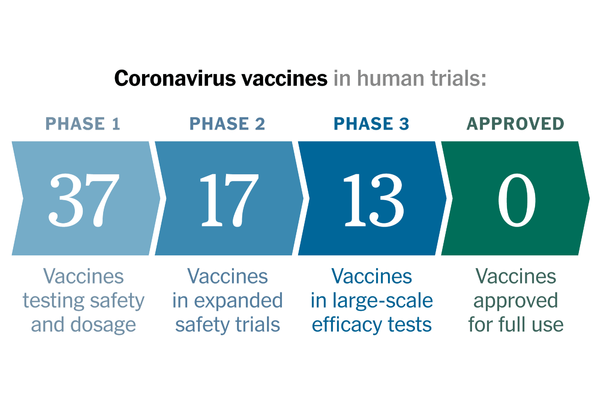
Coronavirus Vaccine Tracker
A look at all the vaccines that have reached trials in humans.
— Noah Weiland and Katie Thomas
Two Chinese port cities mobilize after finding a handful of cases.
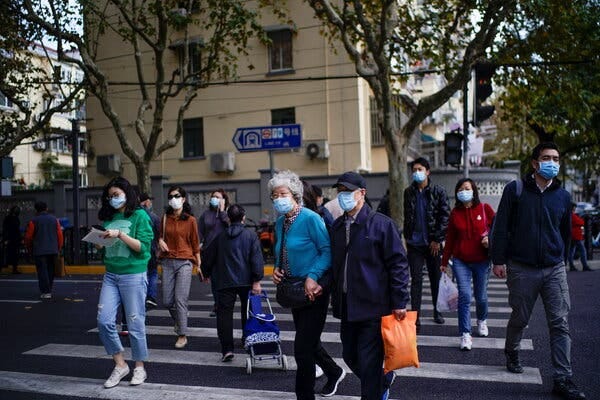
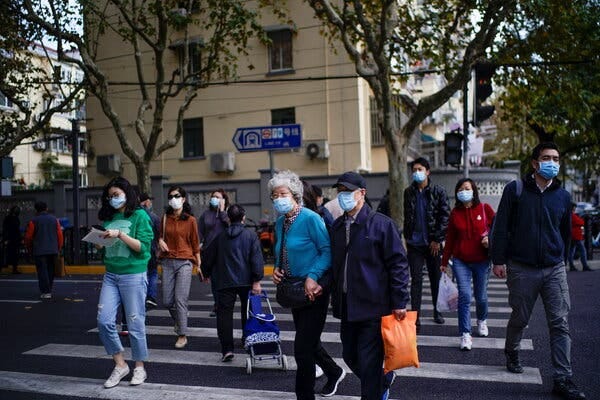
Pedestrians in Shanghai this week. Chinese cities respond to even a single coronavirus case with extensive testing programs.Credit…Aly Song/Reuters
Two of China’s largest port cities, Shanghai and Tianjin, have announced locally transmitted coronavirus infections, renewing worries about whether the country can continue to keep out the virus after coming close to eradicating it over the summer.
Tianjin said on Friday that it had discovered four cases, all in its port area. Shanghai said on Saturday that an airport cargo security officer and his wife, a nurse, had both been infected. The Shanghai cases come less than two weeks after an air cargo worker at the same oceanfront airport, Pudong International, tested positive.
Chinese cities respond to even a single case with extensive coronavirus testing programs. Within hours of the two new cases in Shanghai, local authorities said they had tested six family members of the couple and 80 other close contacts, all of whom were negative. Another 8,120 people in the area were also tested, with more than half of these tests already processed and all negative, officials added.
In Tianjin, the residential community with four new cases was completely sealed off by the authorities. Other neighborhoods nearby, which have people who had been in contact with residents of the sealed-off community, were put under mandatory testing programs, with schools and public places closed and travel restricted.
The Chinese government has repeatedly warned that the virus could re-enter the country on food or other shipments of chilled or frozen goods. Tianjin and Shanghai officials have emphasized that their recent cases were concentrated in areas that handle such goods.
The U.S. Centers for Disease Control and Prevention has said that the virus is primarily airborne. Experts generally say that while it can be transmitted through frozen food and contaminated surfaces, the likelihood is exceedingly low.
National and municipal officials in China have been quick this autumn to blame foreign countries for virus outbreaks on their soil. In addition to extra testing of imported food, the government has made it difficult for Chinese nationals to return from overseas and banned the entry of foreign visitors and many longtime foreign residents.
Amy Chang Chien contributed research.
— Keith Bradsher
Donald Trump Jr. tests positive for coronavirus. He has been isolating since Monday.
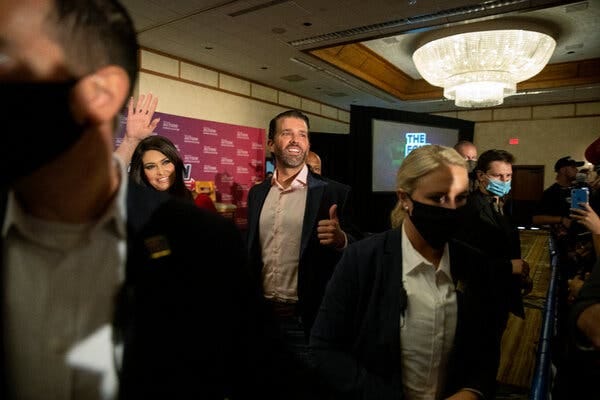
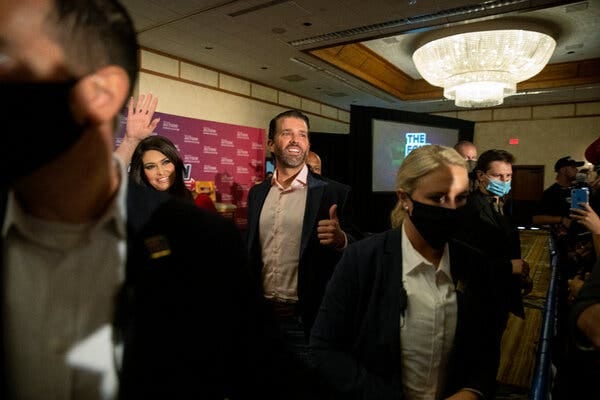
Donald Trump Jr. at a rally in Chandler, Ariz., in September.Credit…Adriana Zehbrauskas for The New York Times
Donald Trump Jr., the president’s son, tested positive for the coronavirus at the beginning of the week and has been isolating since Monday, a spokesman for Mr. Trump said on Friday.
He added that Mr. Trump has shown no symptoms and is following virus protocols.
Mr. Trump is the latest person close to the president who has tested positive for Covid-19. Barron Trump, the president’s youngest son, tested positive last month. Melania Trump, the first lady, also tested positive in October. In July, Mr. Trump’s girlfriend, Kimberly Guilfoyle, had tested positive for the virus.
President Trump tested positive for the virus in October and was hospitalized as his symptoms worsened. The president underwent a series of invasive therapies typically reserved for people seriously sick with Covid-19.
Donald Trump Jr.’s announcement comes hours after Rudolph W. Giuliani’s son, Andrew Giuliani, a special assistant to the president, announced on Twitter that he had tested positive. This week, two Republican senators, Rick Scott of Florida and Chuck Grassley of Iowa, also said they had the virus.
After an exposure to the virus, symptoms can take up to 14 days to appear, if they ever appear at all. In that time, the virus can still spread from person to person.
According to guidelines from the Centers for Disease Control and Prevention, Mr. Trump should isolate for at least 10 days following his positive test. The spokesman did not indicate which test Mr. Trump had taken.
In recent months, Mr. Trump has questioned the seriousness of the coronavirus pandemic, saying in a Fox News interview that since deaths from the virus had dropped to “almost nothing” the outbreak had come under control. That day deaths in the United States topped 1,000.
Mr. Trump’s diagnosis, reported earlier by Bloomberg, comes as the virus is surging across the nation. As of Thursday, at least 1,962 new coronavirus deaths and 187,428 new cases were reported in the United States.
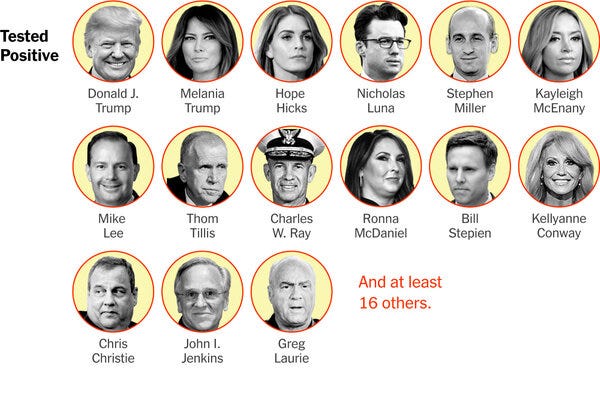
Tracking the White House Coronavirus Outbreak
Several people who were in contact with President Trump or members of his circle have tested positive for the coronavirus in recent days.
— Maggie Haberman
ADVERTISEMENT
Continue reading the main story
Andrew Giuliani, a White House official, tests positive after attending a news conference with his father and other Trump lawyers.


Rudolph W. Giuliani, President Trump’s personal lawyer who is leading efforts to overturn the results of the 2020 election, at a news conference in Washington on Thursday. Also at the lectern were several other lawyers involved in the effort.Credit…Erin Schaff/The New York Times
Andrew Giuliani, a White House official and the son of President Trump’s personal lawyer, announced on Twitter on Friday that he had tested positive for the coronavirus. He is the latest in a string of administration officials, including Mr. Trump himself, to contract the virus.
“This morning, I tested positive for COVID-19. I am experiencing mild symptoms, and am following all appropriate protocols, including being in quarantine and conducting contact tracing,” Mr. Giuliani said.
Mr. Giuliani, who is not known to wear a mask at the White House, attended a news conference on Thursday with his father, Rudolph W. Giuliani, the president’s personal lawyer who is leading efforts to overturn the results of the 2020 election.
The news conference was held in a small room packed with dozens of people at the Republican National Committee in Washington. Three other lawyers that the elder Mr. Giuliani called the president’s “elite strike force” team were also at the lectern: Jenna Ellis, Joseph diGenova and Sidney Powell.
People infected by the coronavirus are thought to be at their most contagious in the two or three days before and after their symptoms start.
At the news conference, the elder Mr. Giuliani, who was not wearing a mask and who was sweating profusely, made a series of baseless allegations about fraud, for which he provided no evidence.
On Friday afternoon, Ms. Ellis, who is a senior legal adviser for the Trump campaign, tweeted that she and the elder Mr. Giuliani had tested negative for the virus. The tweet did not disclose the type of tests they had taken or when they had been tested.
“The entire legal team will continue to follow the advice and protocols of our doctors,” Ms. Ellis said in the tweet.
Because the virus may take several days to ratchet up to detectable levels in the body, a test taken very shortly after exposure might not yield an accurate result, and could, for instance, return a negative result, even if the person is already infected.
The elder Mr. Giuliani and the younger Mr. Giuliani had spent most of the week together, according to a person familiar with their interactions, blurring the timeline during which the virus could have hopped from one to the other.
According to guidelines from the Centers for Disease Control and Prevention, exposed individuals should complete a 14-day quarantine, regardless of whether they test negative during that window.
Andrew Giuliani is only the latest case in what one White House official not authorized to speak publicly described on Friday as another outbreak at the complex. There are at least four other people who have tested positive in recent days in addition to the younger Mr. Giuliani, said the official.
Those test results have come as the small dining room near the West Wing, often referred to as the Navy Mess, was reopened this week with limited seating, the official said.
“Any positive case is taken seriously,” Judd Deere, a White House spokesman, said Friday. “Contact tracing has been conducted by the White House Medical Unit consistent with C.D.C. guidelines to stop further transmission and appropriate notifications and recommendations have been made.”
There have been at least a few events at the White House after which several people in attendance tested positive for the virus. On Sept. 26, there were events in the Rose Garden and indoors for Judge Amy Coney Barrett’s nomination to the Supreme Court, where maskless officials and guests shook hands, hugged and made conversation. On election night on Nov. 3, there was a party at the White House where hundreds of people mingled for hours, many without masks.
In early October, Mr. Trump himself was hospitalized for a few days after testing positive and developing Covid-19 symptoms. More recently, officials who have tested positive for the virus include: Mark Meadows, Mr. Trump’s chief of staff; Corey Lewandowski, a campaign adviser; and Ben Carson, the housing secretary. All were present at the election night party.
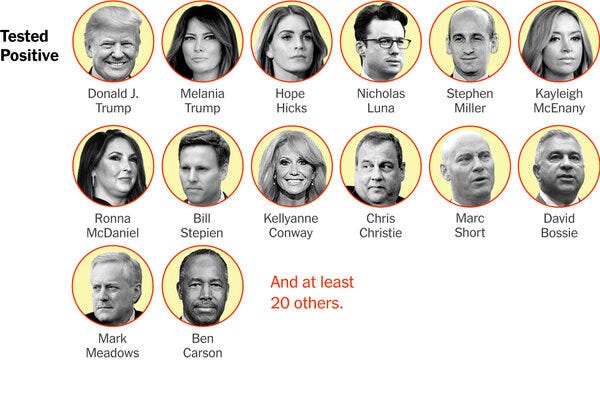
White House Outbreaks Persist, as Cases Now Span Three Months
After a small White House outbreak in September and a wave of cases in early October, the coronavirus has returned to the top of the Trump administration.
— Maggie Haberman and Katherine J. Wu
Senator Rick Scott of Florida is the latest member of Congress to test positive.
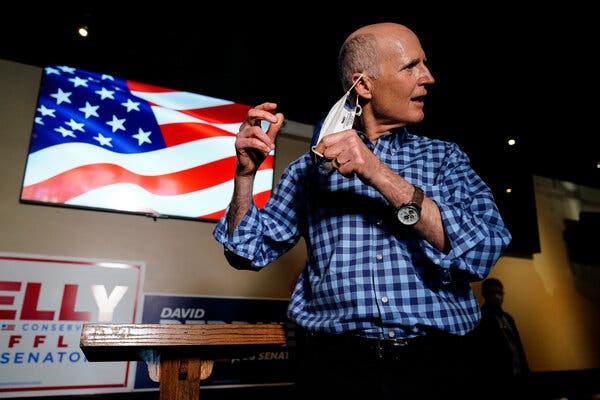

Senator Rick Scott of Florida, at a campaign rally for two Republican Senate candidates in Georgia last week.Credit…Brynn Anderson/Associated Press
Senator Rick Scott, Republican of Florida, said Friday he had tested positive for the coronavirus, the latest prominent lawmaker to contract the rapidly spreading virus that has infected at least eight members of Congress over the past week.
Mr. Scott, 67, said he has been in quarantine at his home in Naples since last Friday, after he came into contact with someone in Florida who later tested positive for the virus. He said he took multiple rapid tests earlier in the week that came back negative, but a P.C.R. test he took Tuesday came back positive Friday.
P.C.R.-based tests are slower, but much more accurate than rapid tests, which are prone to missing the virus when it is present at only low levels in the body. It can also take several days after an exposure for someone to turn positive on a coronavirus test, even if they are already infected.
In a statement, Mr. Scott said he was “feeling good” and experiencing only “very mild symptoms.” He said he would work from home until it is safe to return to Washington. The Senate is not expected to resume work until the end of the month.
He encouraged Americans to wear masks, keep their distance from others and go into quarantine if they encounter someone who is positive for the virus.
“As we approach Thanksgiving, we know this holiday will be different this year,” he said. “But, listen to public health officials and follow their guidance. We will beat this together, but we all have to be responsible.”
Some months ago, Mr. Scott opposed a mask mandate but argued that everyone should choose to wear them. Like most lawmakers, he has taken off his mask when speaking at a microphone. In the past month, reporters at news conferences have started insisting that lawmakers keep their masks on.
Since Nov. 12, eight members of Congress — including two senators, Mr. Scott and Chuck Grassley of Iowa — have reported testing positive for the virus.
Mr. Grassley, 87, a Republican who announced that he had tested positive on Tuesday, wrote on Twitter on Wednesday that he remained “symptom free & in isolation.”
Members of the House who tested positive over the past week include six Republicans: Don Young, 87, of Alaska; Tim Walberg, 69, of Michigan; Dan Newhouse, 65, of Washington; and Doug Lamborn, 66, of Colorado; and two Democrats, Cheri Bustos, 59, of Illinois; Ed Perlmutter, 67, of Colorado.
— Luke Broadwater
As the U.S. outbreak grows with alarming speed, political conflict hampers the response.
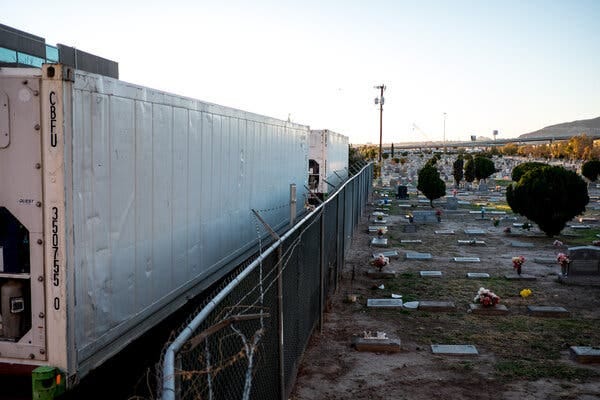
Refrigerated temporary morgue trailers parked next to a cemetery in El Paso last week.Credit…Joel Angel Juarez for The New York Times
Maps tracking new coronavirus infections in the continental United States were bathed in a sea of red on Friday morning, with every state showing the virus spreading with worrying speed and health care workers bracing for more trying days ahead.
More than 250,000 people have died in the United States, a number that grew by another 1,962 on Thursday. The Covid Tracking Project reported that more than 82,000 people were in the hospital, the highest number of the pandemic.
An urgent message from officials in El Paso County, Texas, seeking to hire temporary morgue attendants drove home the reality of what the soaring numbers will mean for communities across the country.
“All applicants must be able to lift between 100 to 400 pounds, with assistance,” the job notice said, according to The Texas Tribune. “Not only is the assignment physically taxing, but it may be emotionally taxing as well.”
As the picture across the country grew more dire, and the Centers for Disease Control and Prevention warned people against traveling and visiting family for the Thanksgiving holiday, the White House coronavirus task force appeared in public for the first time in months, along with Vice President Mike Pence, who said the country was in fine shape.
“America has never been more prepared to combat this virus than we are today,” Mr. Pence declared. “We approach this moment with the confidence of experience. We know the American people know what to do.”
He did not wear a mask and did not take questions.
By contrast, the Trump administration’s coronavirus response coordinator, Dr. Deborah L. Birx, appearing at the same news briefing, issued a dire assessment of the pandemic, urging Americans to “increase their vigilance” as they await the approval of a vaccine.
Dr. Birx came armed with alarming statistics and a still-more-alarming map of the country that was a vast expanse of bright red.
She implored Americans to practice social distancing and to wear masks, one of which she wore herself as she delivered her remarks.
“Every American needs to be vigilant in this moment,” she said, “because we know when you are we can mitigate this virus and stop the spread together.”
But togetherness eluded the politically divided nation. State and local governments continued to go their own way in fighting the pandemic, and President-elect Joseph R. Biden Jr. was still arguing in vain for the access that might prepare him to do his job.
After meeting with health care workers on Thursday, he lambasted President Trump for blocking “access to all the information we need” about vaccinations and other virus data.
“There is no excuse not to share the data and let us begin to plan,” he said.
Mr. Biden vowed quick action after he takes office but promised not to impose a national shutdown. Asked about the president’s erratic behavior as he fights to overturn the results of a free and fair election, Mr. Biden responded with two words: “Totally irresponsible.”
— Marc Santora and Eric Nagourney
ADVERTISEMENT
Continue reading the main story
Health care systems struggle as newly detected cases approach 200,000 a day in the U.S.

Lining up at a drive-through testing site at Dodger Stadium in Los Angeles on Wednesday.Credit…Ringo H.W. Chiu/Associated Press
The pandemic had been raging for months when the United States reported 100,000 daily coronavirus cases for the first time on Nov. 4.
It was a stunning number that showed a virus spreading out of control.
Less than three weeks later, the country is edging closer to reporting 200,000 newly detected infections every day — at the very moment that cold weather is driving people indoors in many parts of the country and the holiday season beckons people to gather together.
More than 198,500 cases were announced nationwide on Friday, another single-day record, and daily tallies have been rising in 47 states, according to a New York Times database.
In discussing the current spread on CNN on Friday, Dr. Deborah L. Birx, the White House coronavirus coordinator, said, “This is faster, it is broader and, what worries me, is it could be longer.”
In California alone, officials reported more than 13,000 cases, a single-day record, prompting the state to announce a 10 p.m.-to-5 a.m. curfew for all but essential workers.
Even if the current seven-day national average of about 166,000 daily cases were to hold until the end of the year, nearly seven million more people would contract the virus. That is roughly equivalent to about 2 percent of the U.S. population.
The potential consequences — in a nation where 250,000 people with the coronavirus have already died — are devastating.
Many health care systems are close to buckling under the strain, and soaring hospitalizations inevitably mean more fatalities. The Covid Tracking Project reported on Friday that there were more than 82,000 Covid-19 patients in U.S. hospitals, more than ever before.
A recent study by the Kaiser Family Foundation noted that Covid-19 had become the nation’s third-leading cause of death, behind heart disease and cancer. If current trends continue, the death toll could reach 300,000 by New Year’s Eve.
Though talk of effective vaccines has dominated the news cycle in recent days, they are not yet available.
“We are in for a rough period through the end of February,” said Dr. Jessica E. Justman, a professor of epidemiology at Columbia University. “It looks hard to find a way to break it.”
To some extent, the upward curve in new cases had been expected as colder weather drove people to spend more time indoors, where the virus spreads more readily. But wintry conditions are not the only culprit.
Epidemiologists and other experts say the equation for reining in the runaway spread of the virus ought to be simple: The more people wear masks, keep a physical distance from others, wash their hands and avoid crowds (especially indoors), the better the chances of bending the infection curve downward.
But as each state and many cities set their own rules and make their own plans, the nation has no unified approach and no coordinated strategy for balancing the pandemic’s economic and human effects.
— Mike Ives and Neil MacFarquhar
New York City confronts a resurgent virus.

Comments
Post a Comment